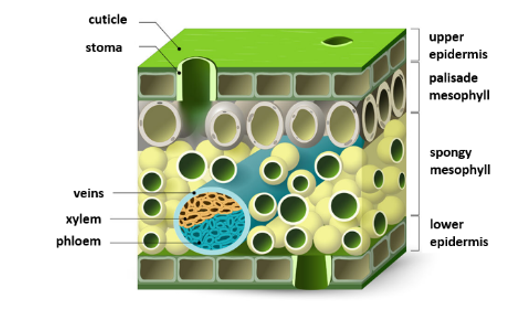In this post
Plants are multicellular organisms and require transport systems in order for them to move water, dissolved nutrients (food) and other substances around their structures.
Transport systems are essential in the plant’s ability to stay alive. Phloem and xylem are continuous tubes located in the leaves and stems of plants. These are two different types of transport tissues. Phloem is responsible for transporting food (particularly sucrose and amino acids) from the leaves to the rest of the plant whereas xylem is responsible for transporting water and mineral ions from the roots to the leaves of the plant.
In young stems, phloem and xylem are grouped together in vascular bundles. These vascular bundles are arranged in the outer part of the stem in a circular shape. However, in the root, vascular bundles are in the central core.

In old stems, the tissue of the vascular bundles grows to form complete rings around the stem. A living layer of phloem is located on the outside, covering the inner layer of xylem which forms the woody central core of the stem.
Key term
Vascular – meaning ‘made of vessels’. A vascular bundle is a group of vessels or tubes, for example phloem and xylem.
Phloem vessels are responsible for transporting food from the stems of a plant to the growing tissues and storage tissues. Phloem consists of tubes that are formed by living cells arranged end-to-end. These living cells have cellulose cell walls and they retain their cytoplasm. Although living cells, these cells have no nucleus but are thought to be controlled by other cells along the lining of the sieve tubes known as companion cells. The end of each cell consists of a sieve plate which is a cross-wall of cellulose with perforations (holes). The cytoplasm of each cell extends through the perforations in the sieve plates which links each cell to the next. This forms a sieve tube which transports the products of photosynthesis from the leaves to other areas of the plant. Young leaves and other growing areas of the plant are brought sugars (sucrose) for energy or amino acids for building proteins. Sugar can also be transported to the roots of the plant for the production of starch for storage.
Key term
Lumen – Lumen refers to two biological terms. Lumen is the inside space of a cellular structure, for example xylem. Lumen also refers to the tubular structure, for example xylem, an artery or an intestine.
Xylem vessels are responsible for transporting water and mineral ions from a plant’s roots to its leaves. Xylem vessels are made up of a hollow lumen and dead cells with thick, strengthened cellulose cell walls. Firstly, water is absorbed from the soil through root hair cells by the process of osmosis (we will discuss this process in detail in the next chapter). The water is then transported up the plant’s stem and to its leaves through the xylem vessels. Finally, water is evaporated from the leaves through the process of transpiration (we will discuss this process in detail in a later chapter). Water molecules tend to stick together which is how when water leaves the xylem to enter the leaf, more water is pulled along behind it.
Look at the following diagram which illustrates the structure of a xylem vessel and a phloem vessel.




